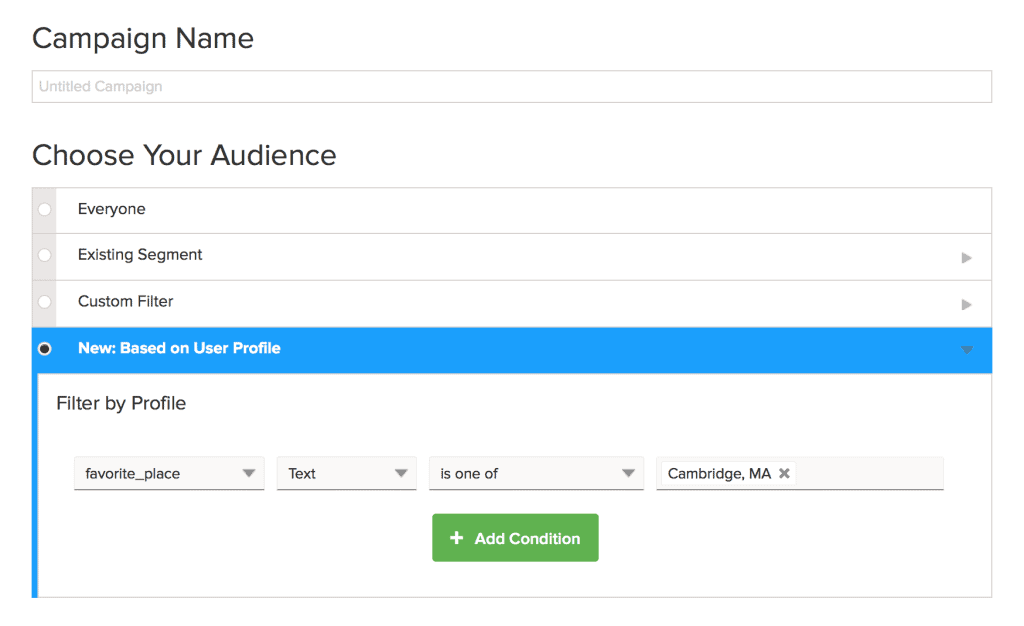As app marketers, we spend a lot of time slicing and dicing analytics data. This makes it easy for us to forget that the numbers represent actual people interacting with our apps… people with hometowns, favorite bands, teams, shoes, and styles of music.
These user characteristics are the driving force behind all behavioral data. And while we can speculate on many user attributes through analytics, but wouldn’t it be nice to know for sure?
Now you can with profile data.
Over the past few months, we’ve published some pretty in-depth content around analyzing behavioral data. And although behavioral and profile data may seem similar, they have some distinct differences.
Behavioral data: shows what users are doing
You guessed it: Behavioral data is all about how the user behaves in your app. How long are users staying inside your app? When do people come back after their first visit? How many people abandoned the checkout process? These types of questions can all be answered with insights from behavioral data.
It’s especially useful to marketers because we can target our users based on this information. Rather than sending blanket push or in-app messages to every user, we can target specific user segments with more personalized language and calls-to-action. When the marketing results come in, you can optimize and repeat with more defined user segments.
Profile data: shows who they are
Profile information is not about how the user behaves; it’s actual characteristics about the user. This can be as simple as favorite sports teams or bands, or as robust as whether or not they use an in-store loyalty card. All of this information can be collected in real-time through the app, or outside the app and imported to your analytics platform.
Examples of profile data
Interest categories
- Sports Teams = Boston Red Sox, Liverpool FC
- Music Artists = Paul Simon, Dr. John
- Hobbies = Guitar, Marketing, Traveling
- News = World, Technology, Finance
Static data
- Birthday = 1982-03-10
- Gender = Female
- Hometown = Checotah, OK
- Annual Income = $200,000
In-app info
- Subscriber Type = Trial
- Linked Twitter Account = True
- Registered User = False
Outside channel attributes
- In-Store Purchaser = True
- Frequent Buyer Member = False
- Rewards Status = Non-member
One of the best features of user profiles is that it doesn’t require the user to sign up or sign in. You can still collect a lot of this information anonymously. This is how an app like Yahoo Weather! can remember my home location, as well as my other favorite locations without ever registering or signing in.
The perfect duo: behavioral + profile data
There was a time when behavioral and profile data existed as separate entities. They knew of each other’s existence, but had never met. One glorious day they were introduced by a mutual app analytics platform, and they never looked back. Although this may sound a little silly, behavioral and profile data do have a truly interdependent relationship with each other. Here are a few examples to illustrate:
#1. The Retail Clothing App
- Offer: 25% discount coupon via push notification
- Behavioral User Segment: Users who have made an in-app purchase within the past 30 days
The Game Changer: Profile Data
While visitors are in your store, offer them an exclusive 25% in-app shopping discount in exchange for making an in-store purchase using their loyalty card.
Why It Works: Not only does this incentivize your shoppers to buy using their loyalty card, it also encourages them to open, engage and shop using your app.
#2. The Daily Newspaper App
- Offer: Free 30-Day Premium Trial
- Profile User Segment: Registered App Users
The Game Changer: Behavioral Data
There is a large segment of users who viewed the “Premium Subscription” page within an app, but never converted. Rather than send one free trial push notification to all registered users, send it only to those who have viewed this “Premium Subscription” section. It’s like remarketing to your own users!
Why It Works: You really don’t have a good idea of whether or not the average registered user is interested in subscribing. It’s best to ease them in with more lightweight conversions like social sharing or clicking on suggested articles. By leaving the free trial to users who are farther down the subscription funnel, you’re spending your marketing dollars (and their screen space) more wisely on user segments who are more likely to respond.
How smart is your app marketing?
Smart app marketing is about communicating important offers to your users with push and in-app messaging. It’s about knowing the difference between your users and how to effectively target them with unique and relevant offers. But the smartest app marketing transcends the app…
The fusion of behavioral and profile data allows you to share web, offline and in-store behavior with your in-app marketing efforts (and vice versa). It provides you with a holistic, cross-platform view of your users resulting in higher levels of engagement and a stronger loyalty to your brand.


